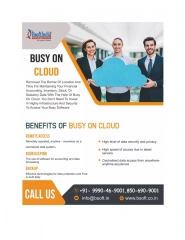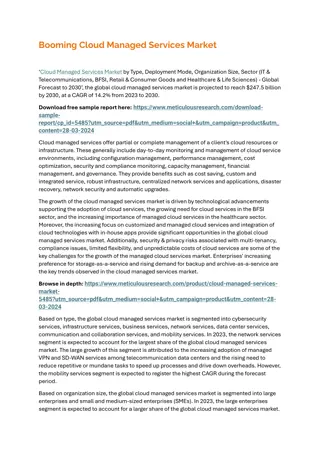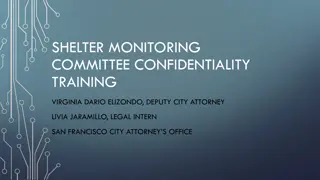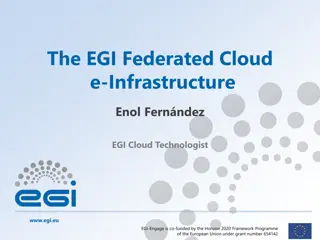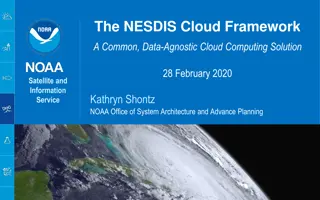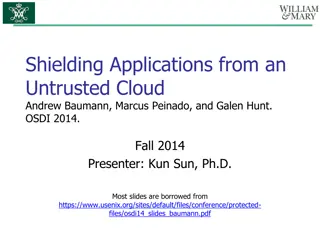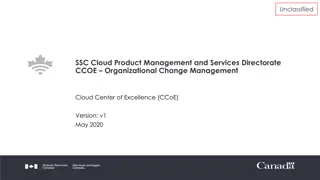Ensuring Data Confidentiality in Cloud Services
Organizations adopting cloud services must prioritize maintaining the confidentiality of sensitive information. Key considerations include data residency, secondary use risks, regulatory frameworks, and contractual agreements with cloud providers. Understanding the implications of data location and legal obligations is crucial to protecting privacy and complying with laws such as GDPR.
Download Presentation

Please find below an Image/Link to download the presentation.
The content on the website is provided AS IS for your information and personal use only. It may not be sold, licensed, or shared on other websites without obtaining consent from the author. Download presentation by click this link. If you encounter any issues during the download, it is possible that the publisher has removed the file from their server.
E N D
Presentation Transcript
Road Map Mobile Security Security Auditing & Risk Analysis WLAN Security Introduction Mobile Network Overview (optional) Evolution of Wireless Network WLAN Overview Evolution of Cloud Cellular Network Security (optional) Infor. Security Essentials WLAN Threats & Vulnerabilities Confidentiality and Integrity of Cloud Mobile Security Threats WLAN Security Cloud Threats & Vulnerabilities WLAN Security Tools Mobile Devices Security (optional) Cloud Security 2
Outline Confidentiality Data Residency Contract for Confidentiality Ensuring Integrity 3
Role of Confidentiality Organisations adopting cloud services need to understand the implications for maintaining the confidentiality of personal or other sensitive business information. The key considerations are how the physical or legal location of data affects its use and ensuring only specified users and devices can view data. Buyers need to understand the regulatory frameworks under which they operate, assess potential providers and draw up suitable contracts to reflect regulatory obligations. 4
Data Residency When considering public cloud services, rather than private or community clouds, an organization needs to understand the potential risk and impact of the secondary use of information. Secondary use of certain information by the provider may violate the laws or terms under which that information was collected. Ex. GDPR Given the variance in privacy legislation across different jurisdictions, the location where information is stored can have significant effects on the protection of privacy and confidentiality as well as on the obligations of those who process or store the information. 5
Data Residency The real horror story for cloud users would be seeing other people s data --Tony Mather, CIO, Clear Channel International business reasons for doing so, it is important to consider whether a provider has: Documented procedures for co-operation with local law enforcement agencies, in order that organisations understand exactly what action would be taken in the event of a data-access request A contractual agreement that prohibits exposure of data without approval, so customers have notice of any proposed hand-over of data to authorities The ability to specify that data reside in particular legal jurisdictions when delivering cloud services to customers in particular countries (to comply with data protection regulations that require data to be stored in given regions). 6
Contract for Confidentiality Where data residency is an important issue, organizations must make sure that this is reflected in the contractual arrangements with their providers. It is important to look for clear policies and practices in order to make an informed decision about the privacy and confidentiality risks. Access control The challenge of multiple logins Granular data control A question of context Caution: evolving architectures Monitor, control, log Cloud can be safer 7
Ensuring Integrity An organisation moving sensitive business data to a cloud environment must take steps to ensure that its data is safe, genuine and accurate. Failing to do so can have both legal and operational consequences. It is therefore important to take data integrity into account as part of the due diligence process when selecting cloud providers. Protecting the integrity of data in a cloud environment is vital. Organizations must: Ensure that data stored using cloud services has not been tampered with Thoroughly address all compliance-related issues Ensure their reputations are protected by working with trusted providers. 8
Ensuring Integrity It is important to ensure providers comply with any regulatory, corporate, industry or other standards relating to cloud services. They must also be able to provide the information their customers require in order to meet their own obligations. To this end, they should be able to demonstrate that: Their systems are secure (e.g. through certification) They can provide an adequate data-audit trail Their terms of use do not jeopardise customers own legislative requirements or ethical codes. 9
Understanding Certification and Standards There are a number of common certifications and standards that providers use to bolster their claims of security and data integrity. The most frequently used are: ISO 27001 the current standard certification for the operation, monitoring, maintenance and improvement of information security management systems ISO 27002 recommendations for information security management (not currently certifiable) ISO/IEC 20000 specifies the minimum process requirements an organization must establish to be able to provide and manage IT services to a defined quality ISO 9001 the most common of a number of quality management certifications. Being certified demonstrates a provider is driven to continually improve its internal, customer-facing and regulatory systems and processes. 10
Auditing and compliance Although cloud computing is a relatively new development, data center management is not. There are already proven tools and formal processes for auditing and testing the security aspects of data centres. For example: Field tests for fail-safety Regular security exercises Formal frameworks for security testing (such as penetration tests) Independent security audits Reports to customers on past service levels. 11
Acknowledgement This course is developed in non-textbook mode. We acknowledge the idea, content, and structure from: The white book of cloud Adoption The white book of cloud Security Mobile security for the rest of us Mobile Security for Dummies https://www.sfh-tr.nhs.uk/media/4866/information-security-mobile-security-for- dummies-ebook.pdf 12









